
34 killed
50 injured
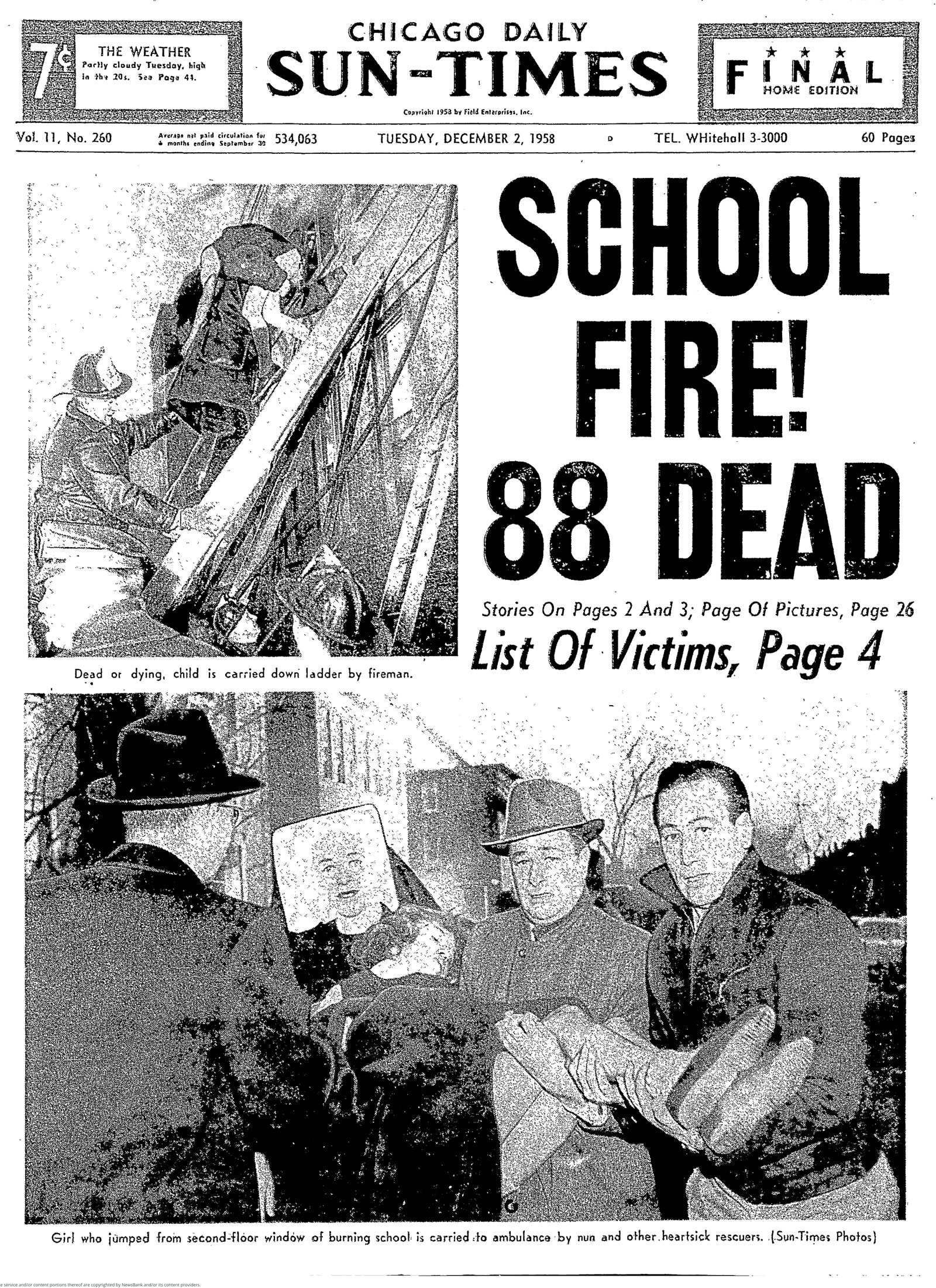
88 killed
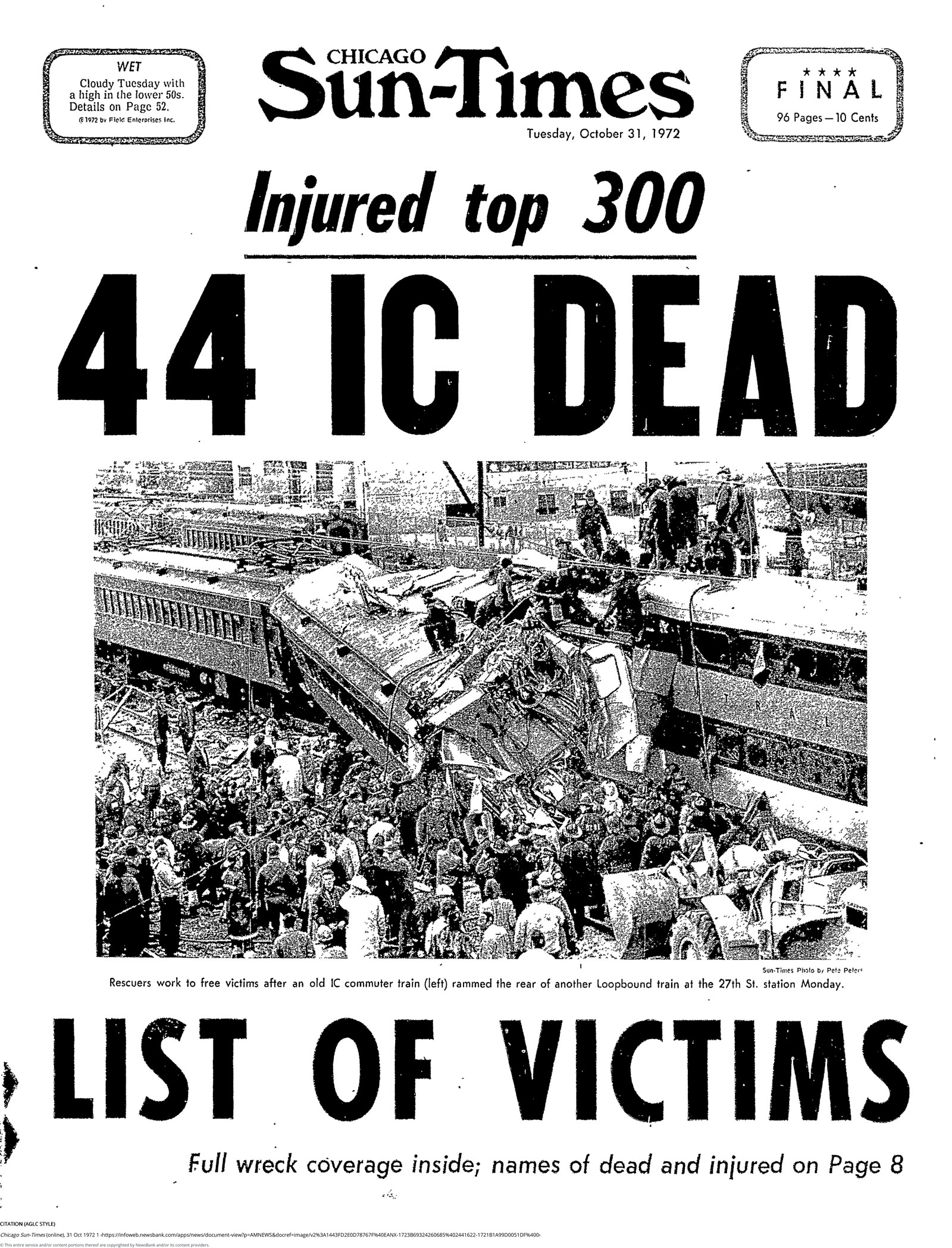
45 killed
332 injured
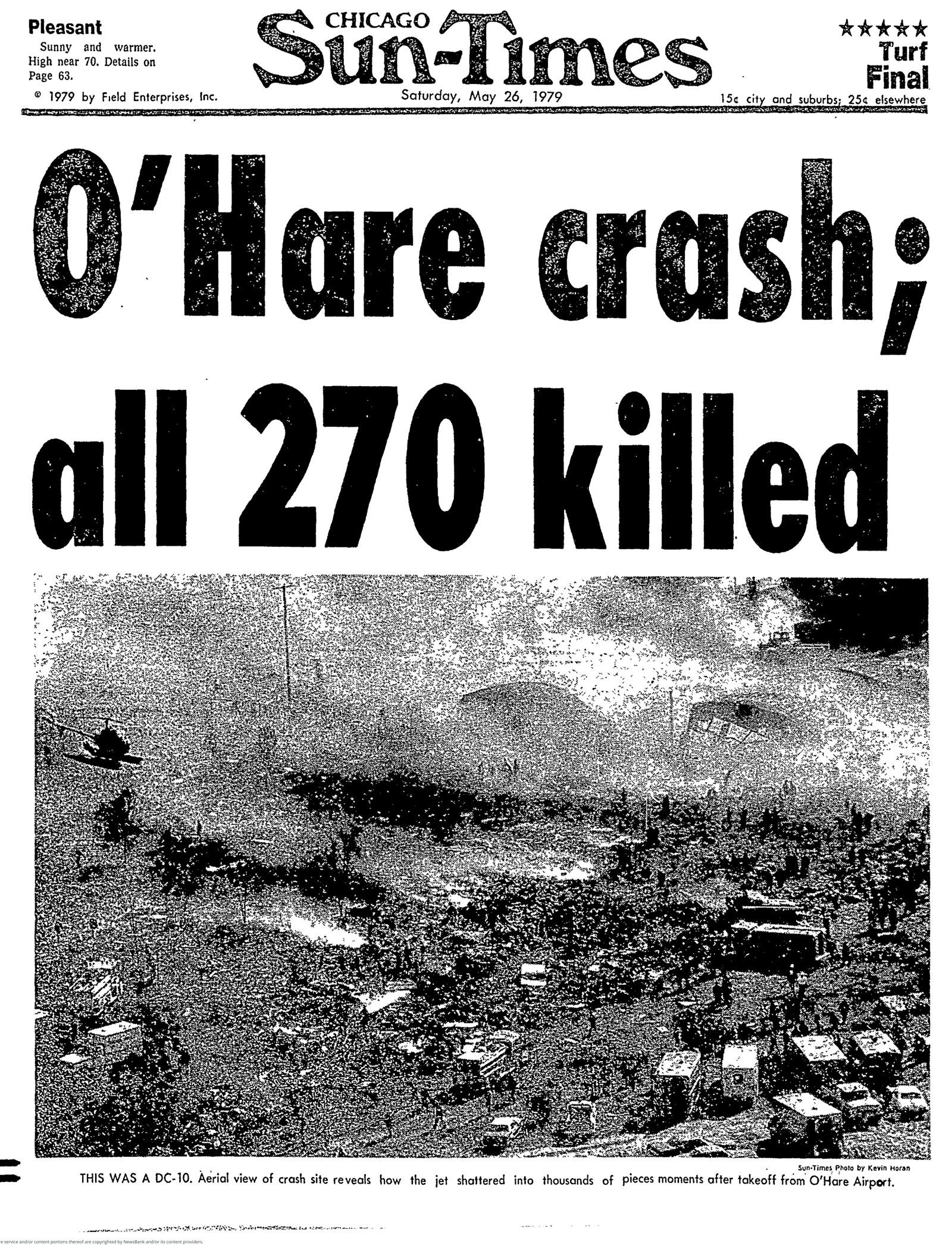
271 killed
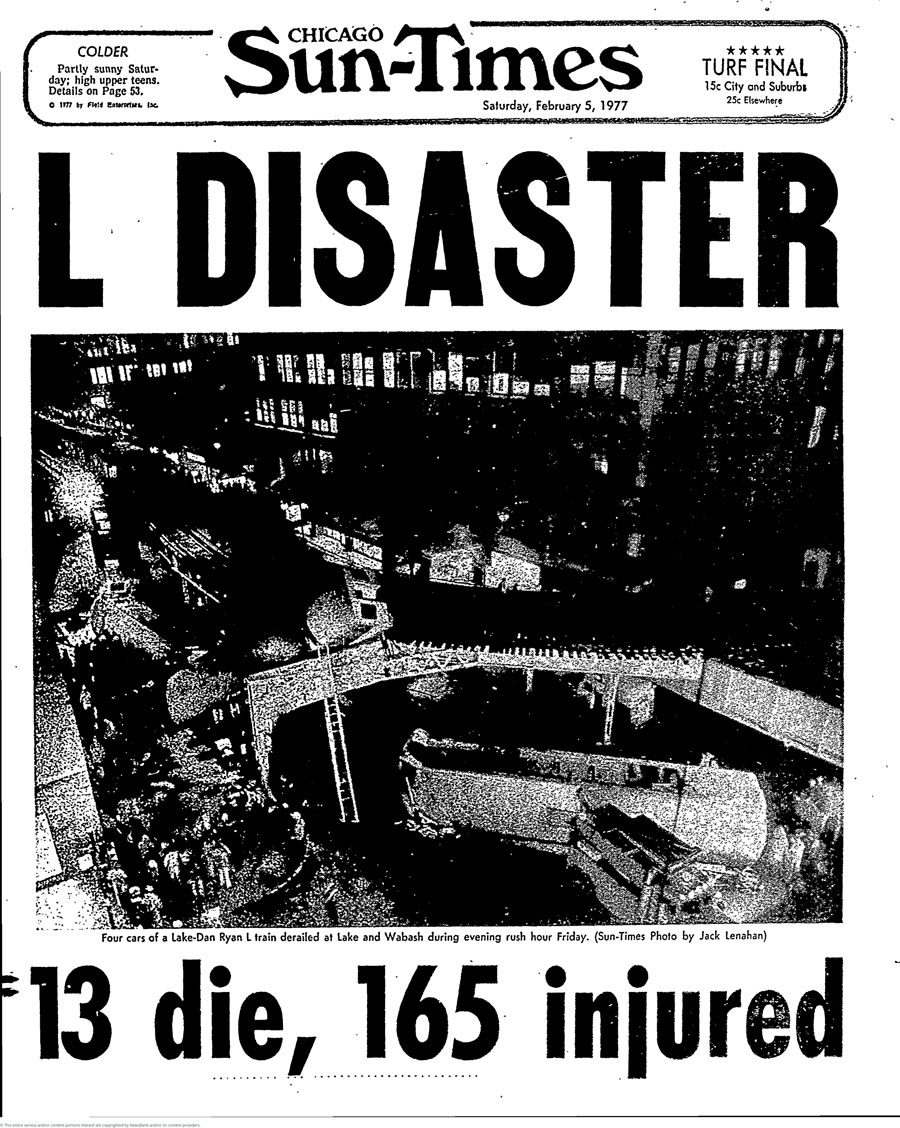
11 killed
180+ injured
A CTA streetcar collides with a gasoline truck.
A Catholic elementary school turns into an inferno.
An Illinois Central rush-hour express train slams into a packed local commuter train.
An American Airlines DC-10 loses an engine while taking off from O’Hare and explodes into the ground.
One L train hits another and tumbles off the elevated tracks.

Rushing to face death then tell the tale
Over its 75-year history, Sun-Times staffers witnessed disasters that are seared into the memory of the city.
For 75 years, Sun-Times reporters and photographers have been hard on the heels of first responders at tragedies great and small. Some are seared into the collective memory of the city. Most are quickly forgotten, except of course by the survivors who lived through them and the journalists who gathered their stories.
One thing that leaps out is the access that newspapers once automatically received. After a CTA Green Hornet streetcar hit a gasoline truck at 63rd and State on May 25, 1950, trapping 34 people who burned alive in the “Death Trolley,” the Sun-Times ran photos of dazed survivors taken at hospitals, of investigators going over charred possessions of victims, of relatives prostrate with grief after identifying their loved ones at the city morgue.
Our Lady of the Angels School fire

In 1958, the Sun-Times and Chicago’s three other major daily newspapers were supplied with spot news by the famed City News Bureau, whose Charles Remsberg — a 22-year-old intern who’d graduated from Medill that June — was at Traffic Court on the afternoon of Dec. 1 when his desk told him to hurry over to Humboldt Park, to Our Lady of the Angels School.
“I ran around to the front of the school,” Remsberg wrote to his parents the next day. “The north side of the building looked like a cereal box in an incinerator. Smoke was pouring out of every window, casting a light fog over the ground area and a dense pall above. At the back of the wing, flames still were leaping up. Police were struggling to keep a huge crowd of adults and children back of the fire lines. After getting a good overall picture of the scene, I headed for the phone. Women in the crowd were hysterical, their faces twisted and wet with tears. Men were holding them back, but they were screaming, ‘Where are they? Where are they?’”
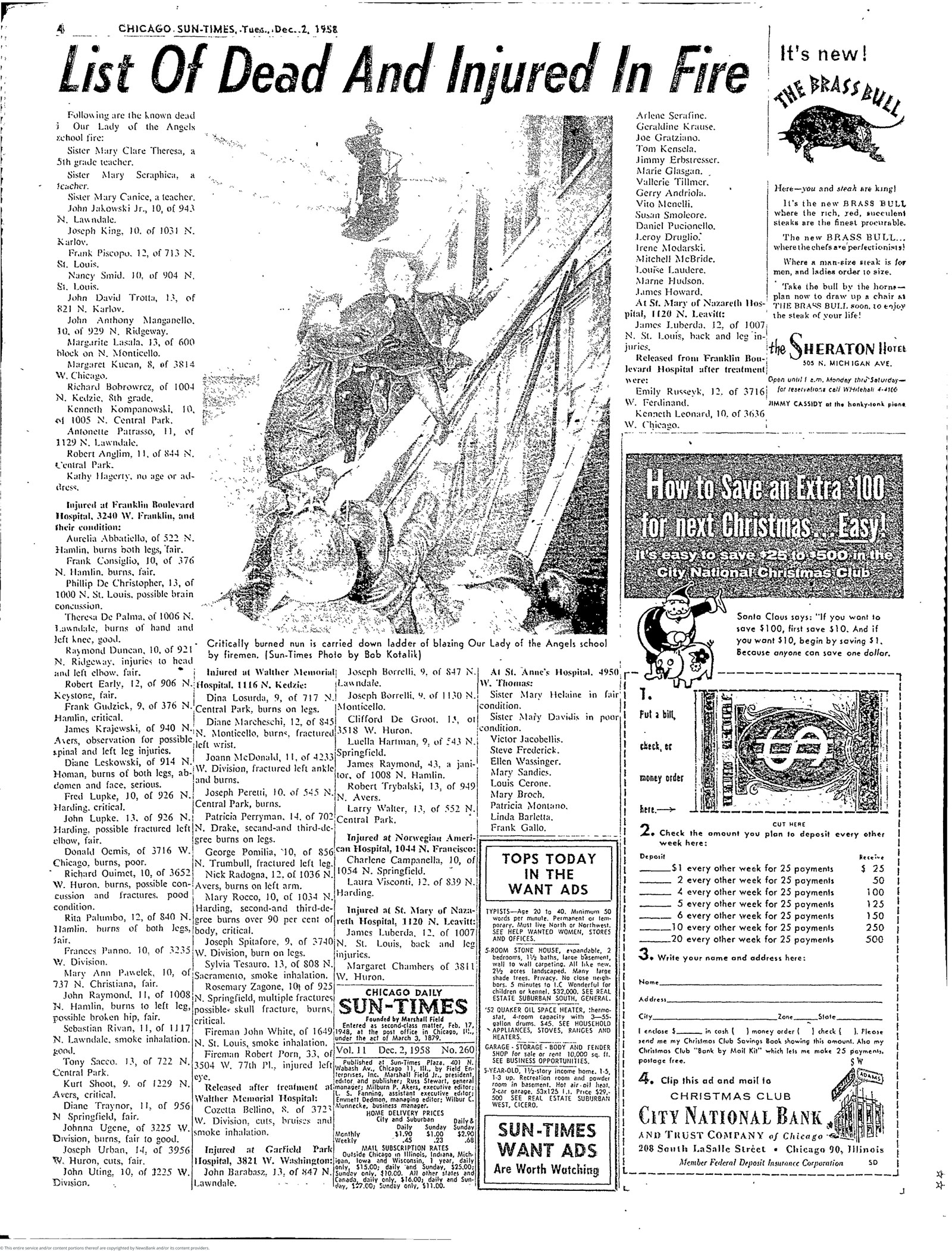
An Updated List of Victims
Ninety-two children and three nuns died in the fire. Covering such stories can take a toll on reporters.
“It was a traumatic experience,” wrote Lois Wille, in John Kuenster’s “Remembrances of the Angels,” recalling how she was a young Chicago Daily News reporter sent to interview a couple whose daughter died earlier that day in the fire. “It was the first story of such tragic proportions that I had worked on.”
Wille, who died in 2019 after a distinguished career in Chicago journalism, including a stint as editorial page editor at the Sun-Times, remembered being “embarrassed and ashamed” to quiz the dead girl’s parents, but also noted how much they wanted to talk about their child. The memory stayed with her.
“I think of the fire quite often,” she wrote in Kuenster’s book.
“These things have come back to me,” agreed Remsberg, now 87, retired and living in Wilmette.
Not so much the scenes of horror, but the awful fact that some parents had a harder time identifying their badly burned children because their jewelry had been stolen from their bodies between the scene and the morgue.
 Charles Remsberg, was an intern at the Chicago City News Bureau when he covered the Our Lady of Angels School fire in 1958. He now lives in Wilmette. Pat Nabong/Sun-Times
Charles Remsberg, was an intern at the Chicago City News Bureau when he covered the Our Lady of Angels School fire in 1958. He now lives in Wilmette. Pat Nabong/Sun-Times
“That was a bit of a sobering experience,” said Remsberg, adding that recent school shootings sometimes cause him to reflect on the 1958 tragedy.
“One image that stuck with me actually occurred a couple days after the fire,” said Remsberg, the father of four children. “City News sent me out there ... there was a man standing on the steps to the main entrance, beating on the doors, yelling, ‘Give me back my babies! Give me back my babies!’ This really impressed me at the time, as I got older and had kids of my own, it really sank in, and that tends to surface these days when I hear about another school shooting with kids involved. Just the fragility of life. You think you are sending your kids off to a safe place and it turns into something quite different.”
1972 Chicago commuter rail crash

One common element of these disasters is how abject horror can suddenly intrude upon an utterly ordinary day.
It was about 7:30 a.m. Oct. 30, 1972, when a commuter train overshot the 27th Street station and the engineer decided to back up to the platform, where an express train plowed into it at 30 mph. Forty-four people were killed and 300 injured.

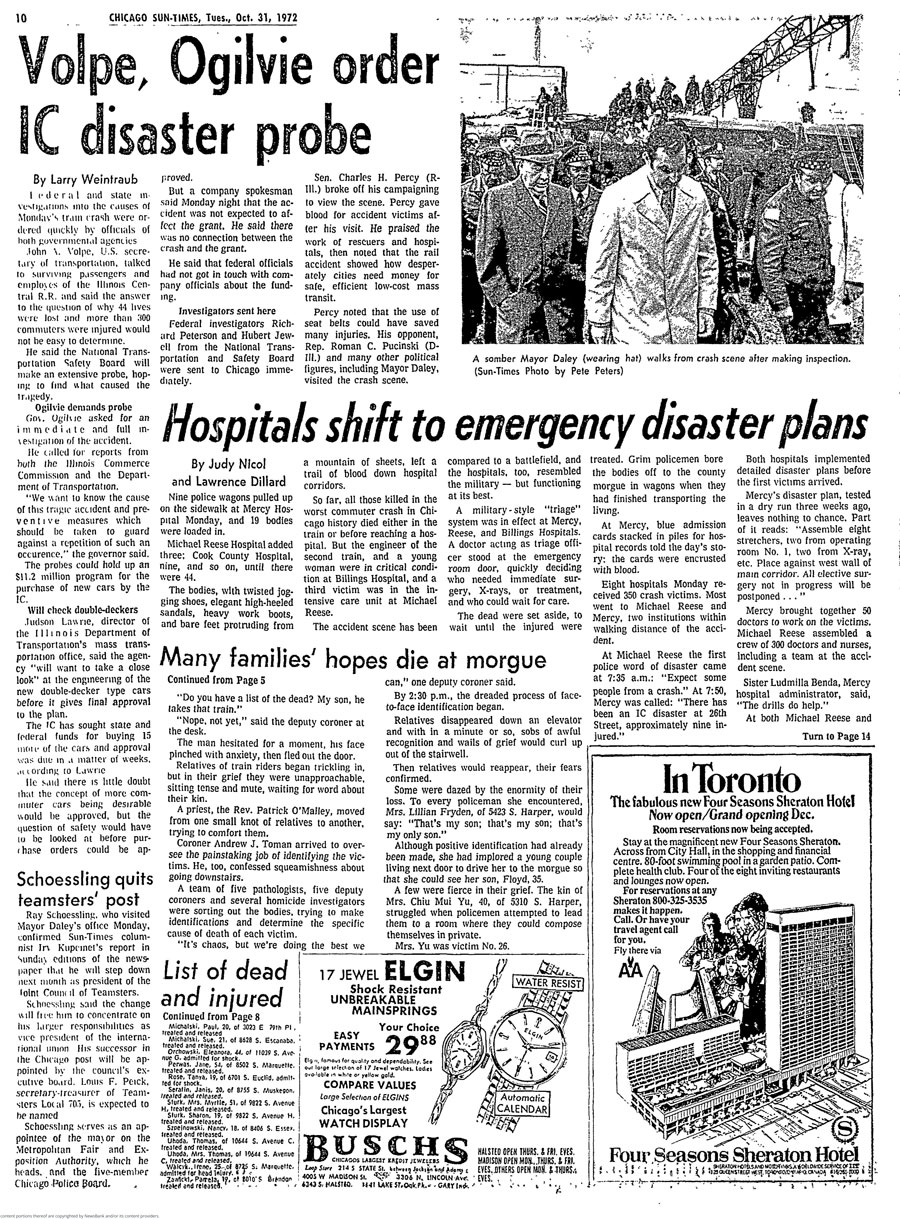
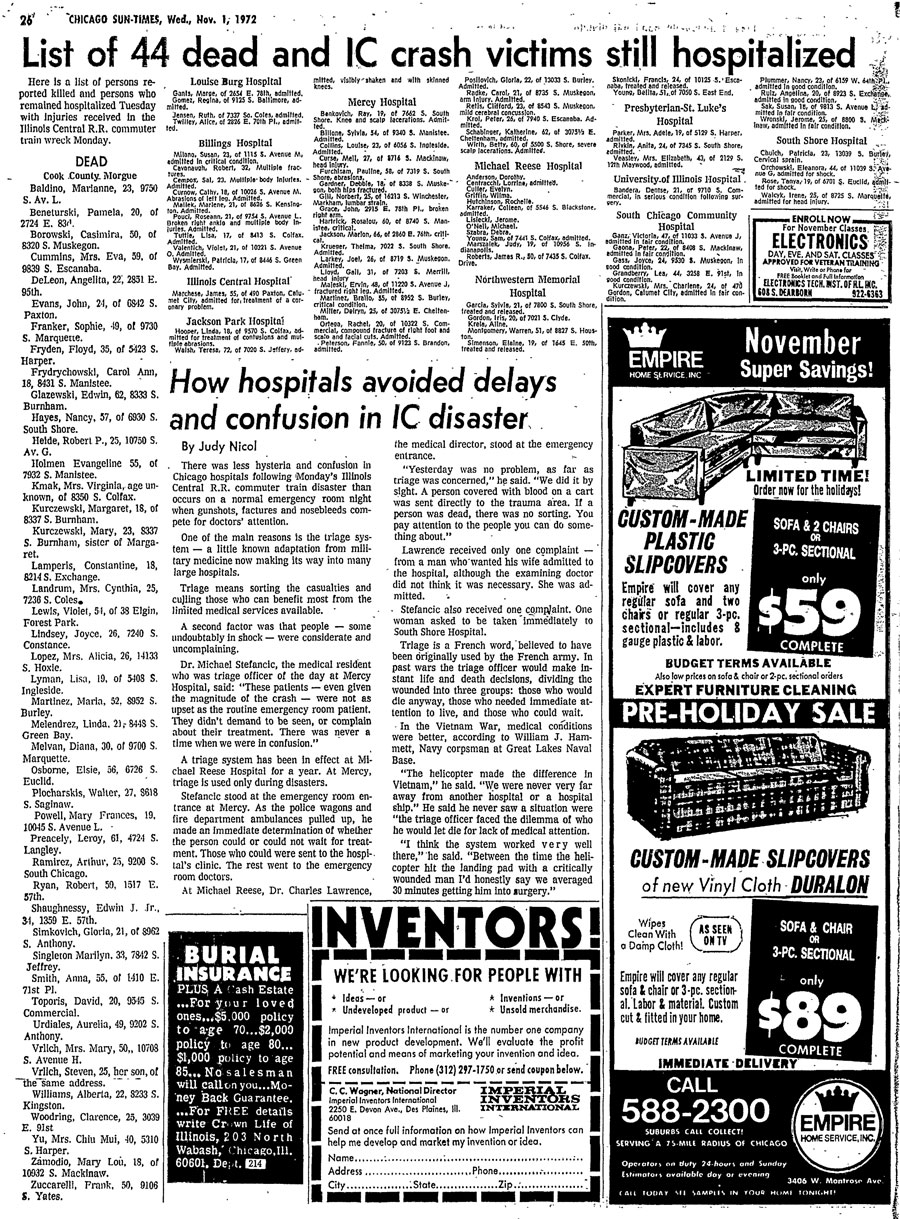
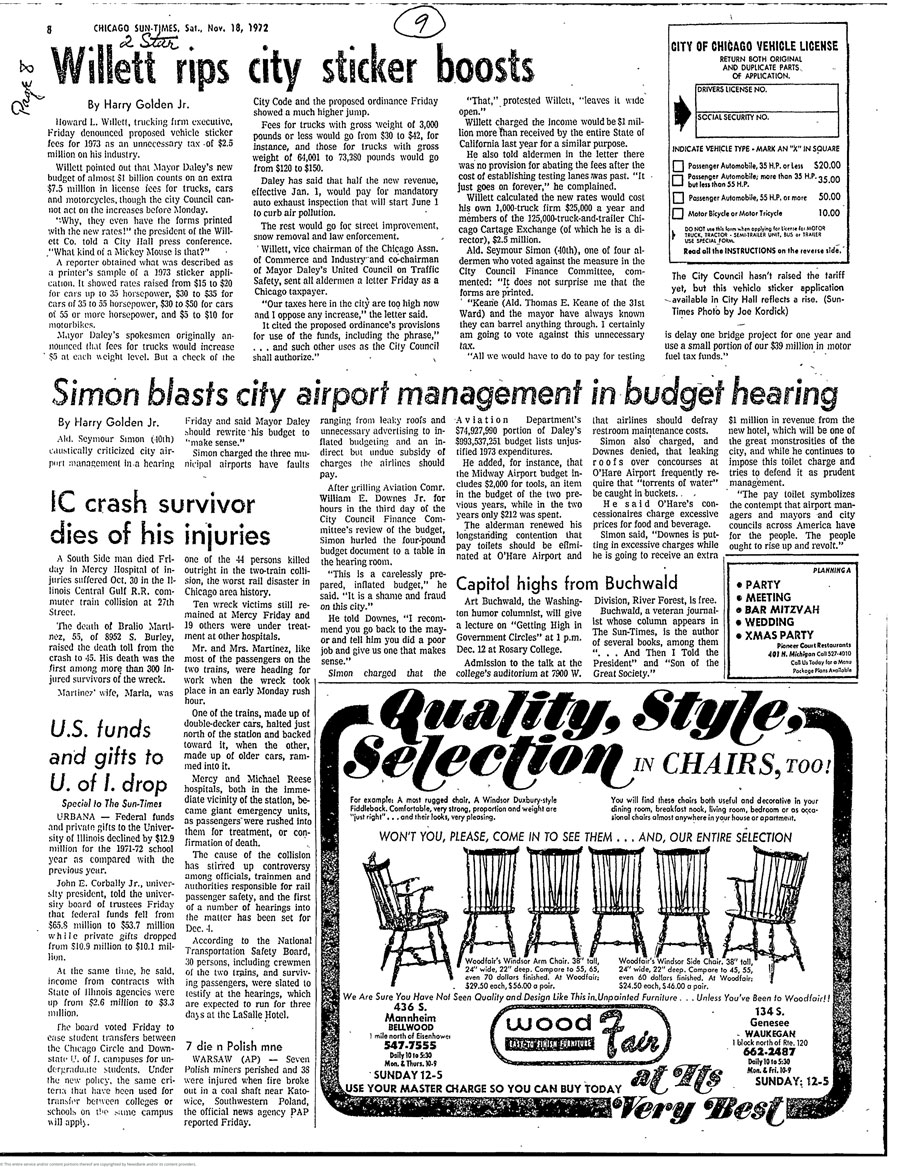
An Updated List of Victims
The Sun-Times had a much deeper bench then, sending seven photographers and 23 reporters to a hellish scene of tangled metal and bloody victims, and to the 11 hospitals where survivors were taken.
One of those reporters was Pulitzer Prize-winning columnist Tom Fitzpatrick, who chronicled the six hours it took firemen to cut a pair of 17-year-old girls, Patricia Wysmierski and Lisa Tuttle, from the wreckage. His story fills a page the next day and begins:
“Please help us,” Patricia cried.
Firefighter Billy Nolan from Snorkel Squad No. 1 heard the voice coming from the front end of the train.
“Are you in pain?” Nolan asked.
“I’m numb,” Patricia said. “I can’t feel my legs.”
American Airlines Flight 191

The paper’s ability to get close to tragedy might seem intrusive now, but it preserves the details of events that nowadays might be screened from view by officials and therefore lost to history.
When American Airlines Flight 191 crashed on May 25, 1979, the Sun-Times put 28 reporters on the story plus a dozen photographers.
Just getting to the story required savvy.
An Updated List of Victims
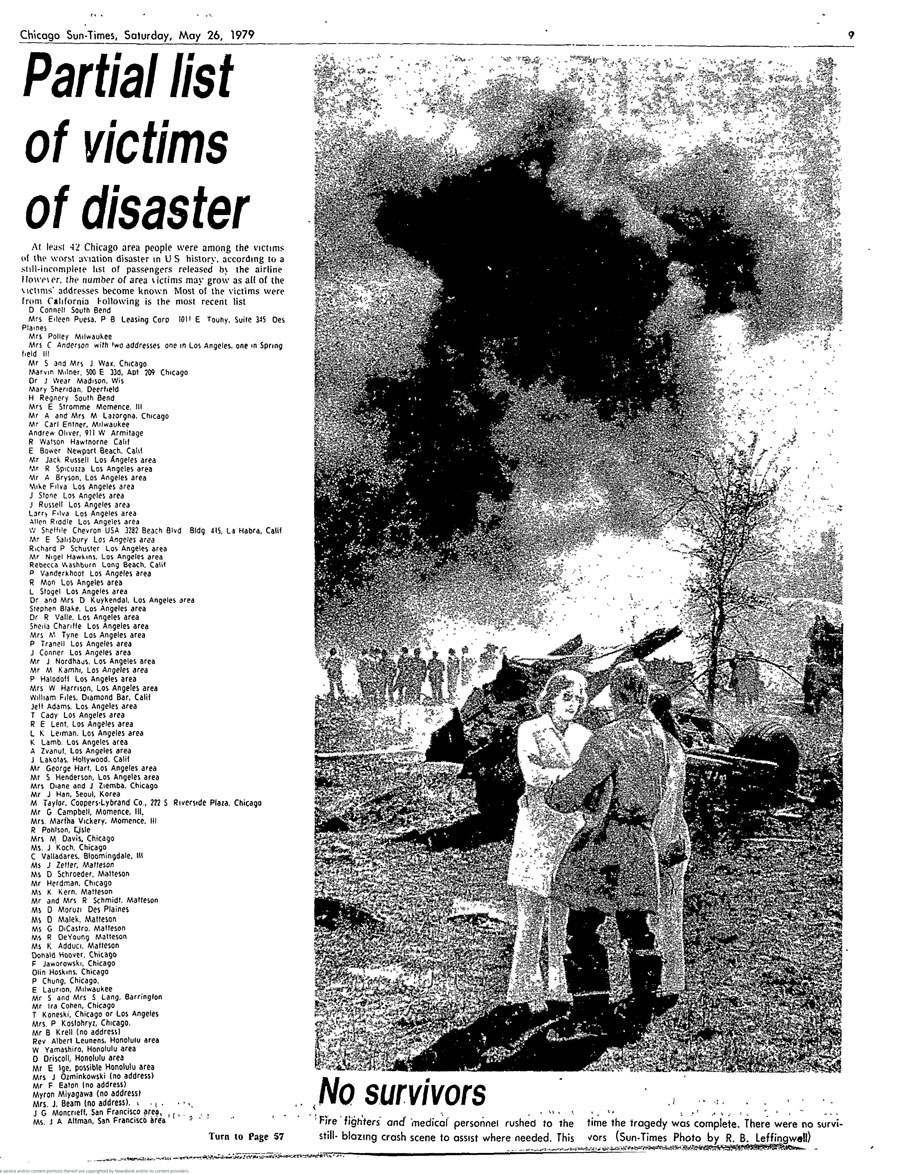
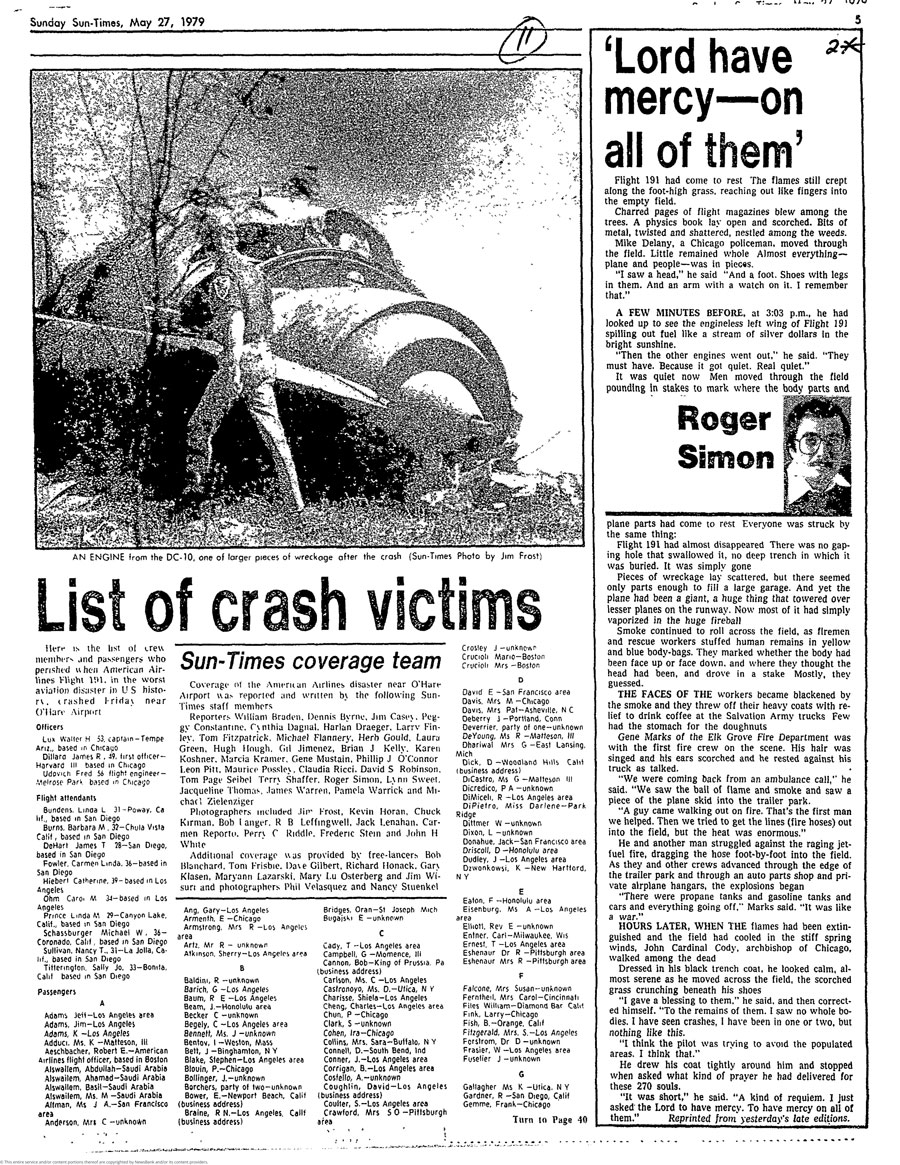
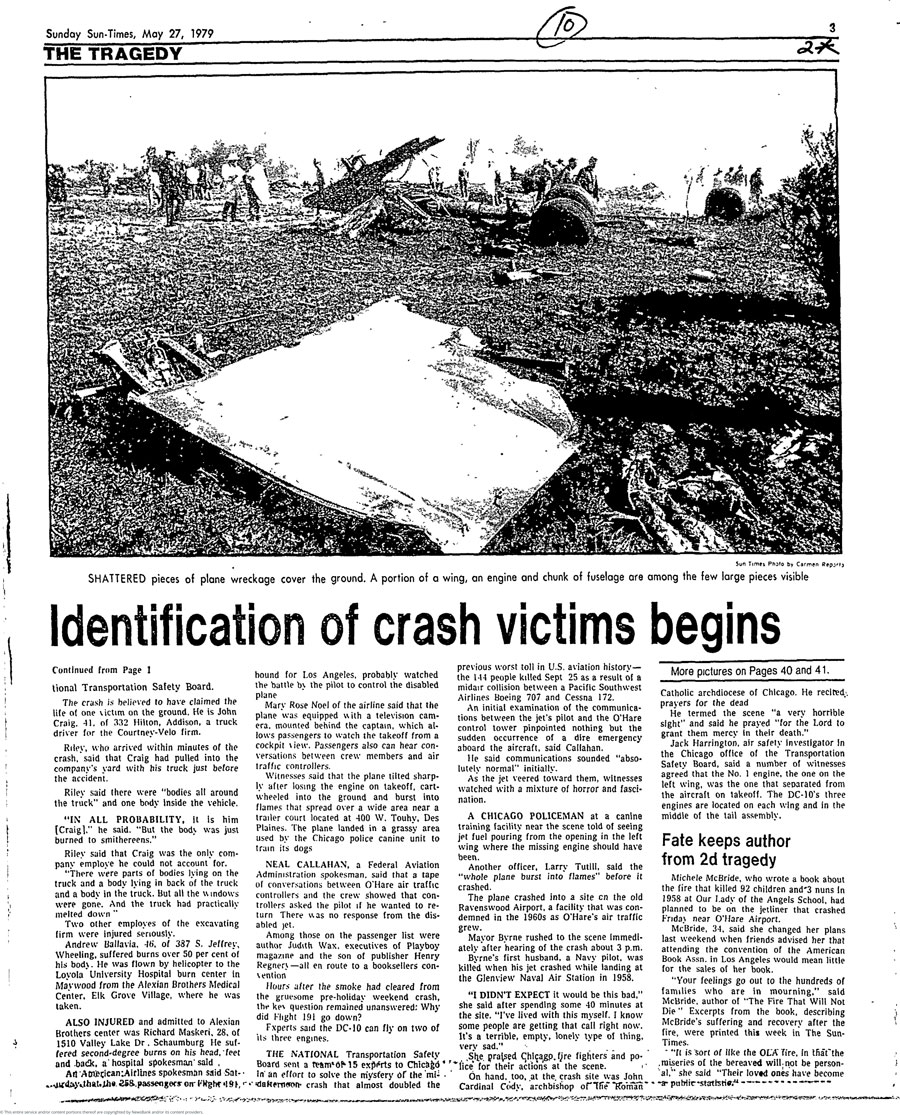
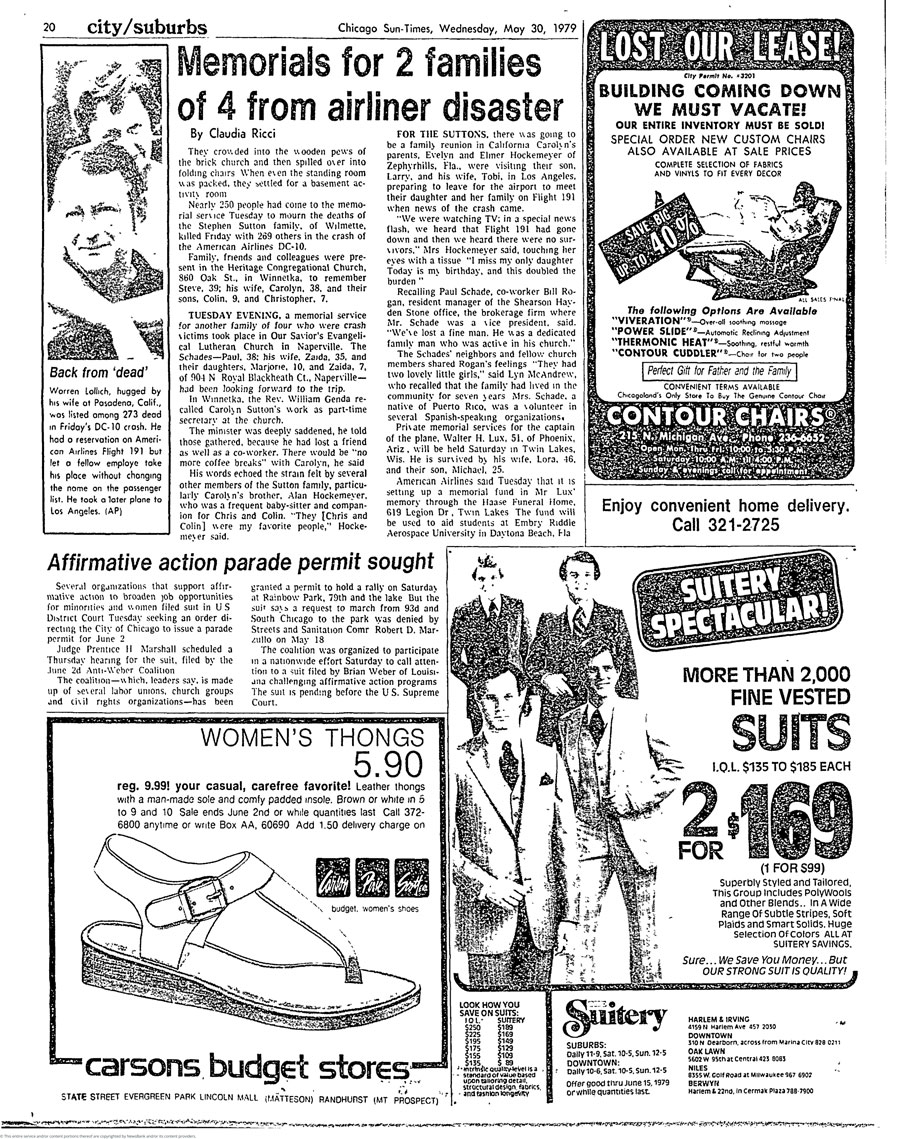
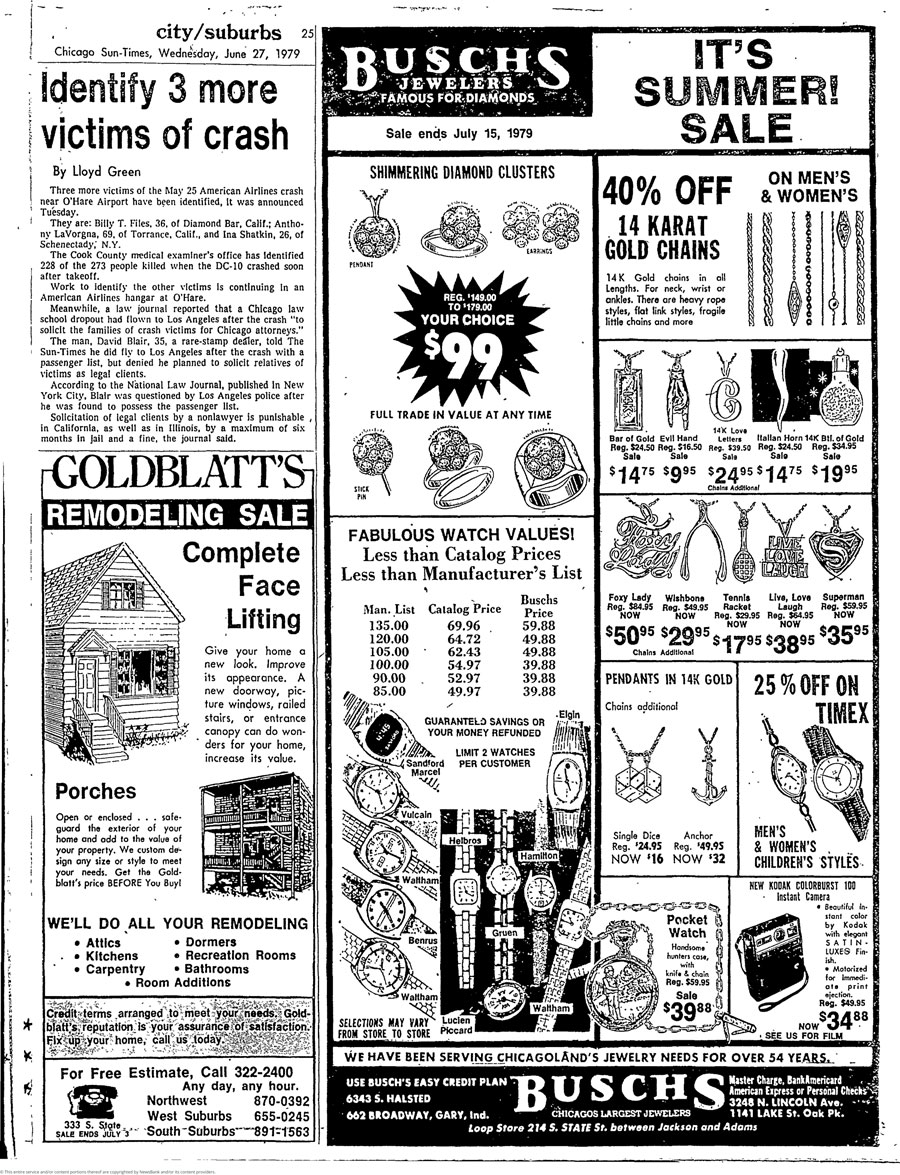
As soon as a phone tip about a crash near O’Hare reached the paper, photo desk chief Bob Kotalik told photographer Randy Leffingwell to go there. But where? No time to find out. Leffingwell hurried to the Chicago Fire Department headquarters, several blocks away from the newspaper at 401 N. Wabash.
“Since none of us really knew exactly where the plane had gone down, I figured CFD was certainly going to send several chiefs with accurate directions,” Leffingwell remembered. “So I drove straight there and was lucky enough to tag onto the tail end of a convoy of chiefs, ladder trucks, pumper engines and ambulances. I just stayed right behind them.”
The first task of a photographer in that situation is to take an establishing shot of the general scene, in case they get chased away. But Leffingwell, arriving at a smoky field, at first couldn’t understand what he was looking at.
 An aerial view of the scene where American Airlines Flight 191 crashed on May 25, 1979. The DC-10 crashed after takeoff from O’Hare International Airport. Kevin Horan/Sun-Times
An aerial view of the scene where American Airlines Flight 191 crashed on May 25, 1979. The DC-10 crashed after takeoff from O’Hare International Airport. Kevin Horan/Sun-Times
“I couldn’t make any sense of what was there,” he said. “None of the fire crews or ambulance teams were running. All the police and fire radios had completely calmed down. Ambulances were just parked. And where was the plane? Where the hell was the plane? The huge field was scorched and smoking, but there was no wreckage.”
Shielded by the grass were countless horrors.
“Careful where you walk,” a firefighter told Leffingwell. “It’s everywhere.”
Columnist Roger Simon also walked carefully through the field beyond runway 14L.
“Charred pages of flight magazines blew among the trees,” he wrote. “Bits of metal, twisted and shattered, nestled among the weeds. ... Men moved through the field pounding in stakes to mark where the body parts and plane parts had come to rest.”
One of the first photographers on the scene was Bob Ringham.
“I was on my way to cover a White Sox game,” he remembered. “I had a ’79 Malibu that kind of looked like a police car.” So he followed a pair of Illinois State Police cars, sirens blaring, to the scene.
“It was surreal. Literally, charred bodies everywhere. A decapitated head in a tree. I was right in the middle of that plane crash,” said Ringham. “It was mind-boggling.”
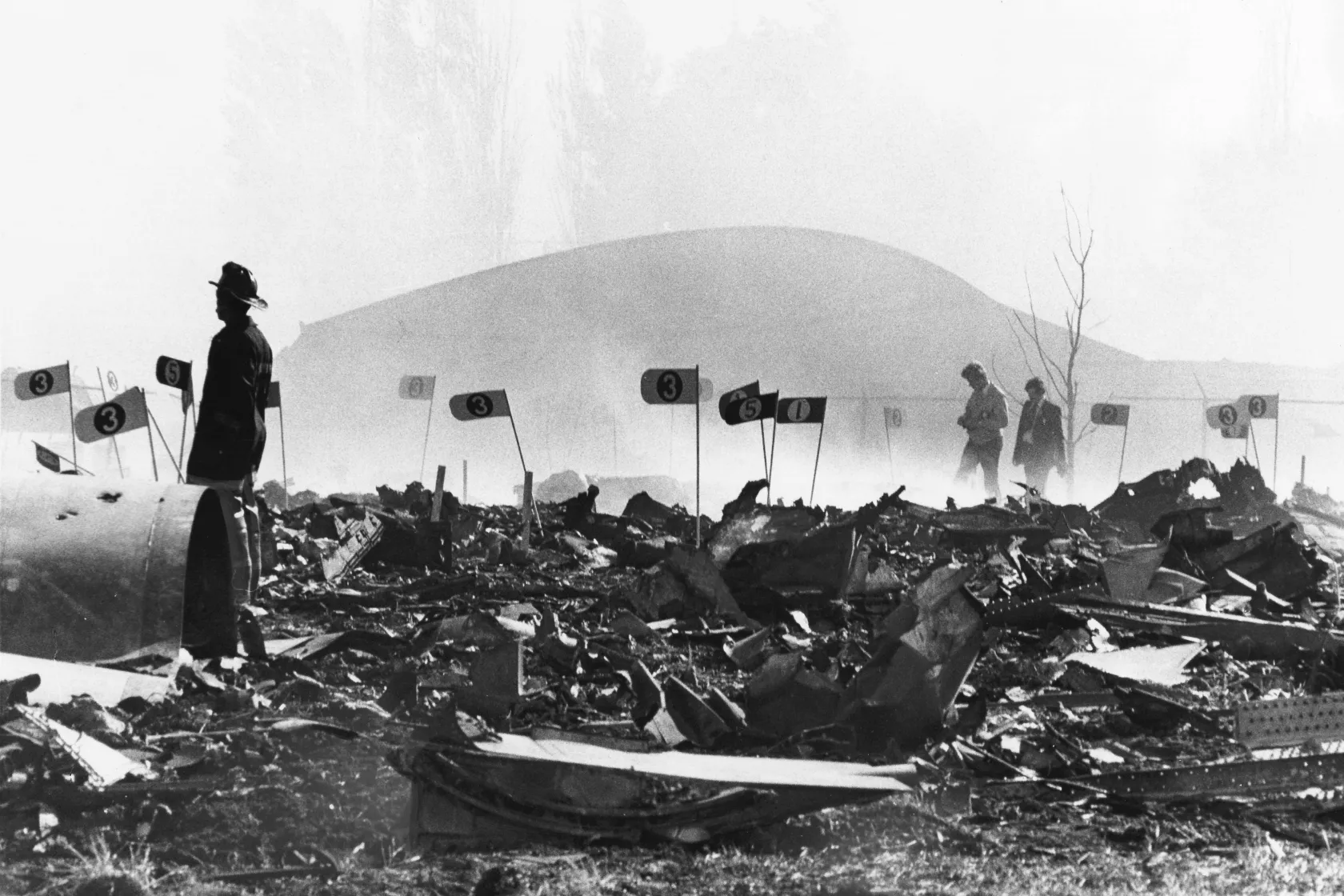 Pennants on sticks mark the locations of bodies strewn among the wreckage of the DC-10 airliner that crashed just after takeoff from O’Hare Airport on May 25, 1979. Phil Velasquez/Sun-Times
Pennants on sticks mark the locations of bodies strewn among the wreckage of the DC-10 airliner that crashed just after takeoff from O’Hare Airport on May 25, 1979. Phil Velasquez/Sun-Times
His military experience helped steady him.
“Being a former Marine, I saw so much death in Vietnam,” he said. “You just block it out and do your job. Then they set the police lines up, and I was moved out of there. I didn’t want to get arrested.”
Not getting arrested is a constant challenge when covering disasters. Ringham was still shooting for the Daily Herald in 1979, but moved to the Sun-Times and in 1985 was part of a team sent to Mexico City after a colossal earthquake — 8.0 on the Richter scale — killed thousands of people.
Ringham was trying to photograph hundreds of shrouded bodies being loaded into a mass grave at night when a jeep roared up and he found himself staring down the muzzle of a .50-caliber machine gun.
“I realized I better not take any pictures,” he said. The soldiers beat up his driver and took him and reporter Jim Martinez away. “I thought we were going to jail,” Ringham said. Instead, he met a Mexican army captain with relatives in Chicago.
“We held up our Chicago press passes, and he looks at me and says, ‘Are you Mexican?’ I said, ‘No, I’m from Chicago.’ He said, ‘You’re from Chicago? I have cousins in Chicago!’ He hugs me, and lets us go.”
That didn’t solve all Ringham’s problems. It was also a long way to Chicago, and no internet to zip his photos back.
“How do you get your film back to Chicago?” said Ringham. “I would go out to the airport, and ask two young women: ‘Are you going back to Chicago? Can I give you my film — not drugs, just film, can you take it and call this number? They will give you $100 dollars.’ They did it. After that, airline pilots would take it.”
Such trips were rare. The Sun-Times is a metropolitan paper, but occasionally a disaster was of such a scale we’d send reporters and photographers out of town, such as to the Mexican earthquake, or 9/11, when reporters Bryan Smith and future Pulitzer winner Frank Main spent almost a week at the ruins of the World Trade Center in New York City.
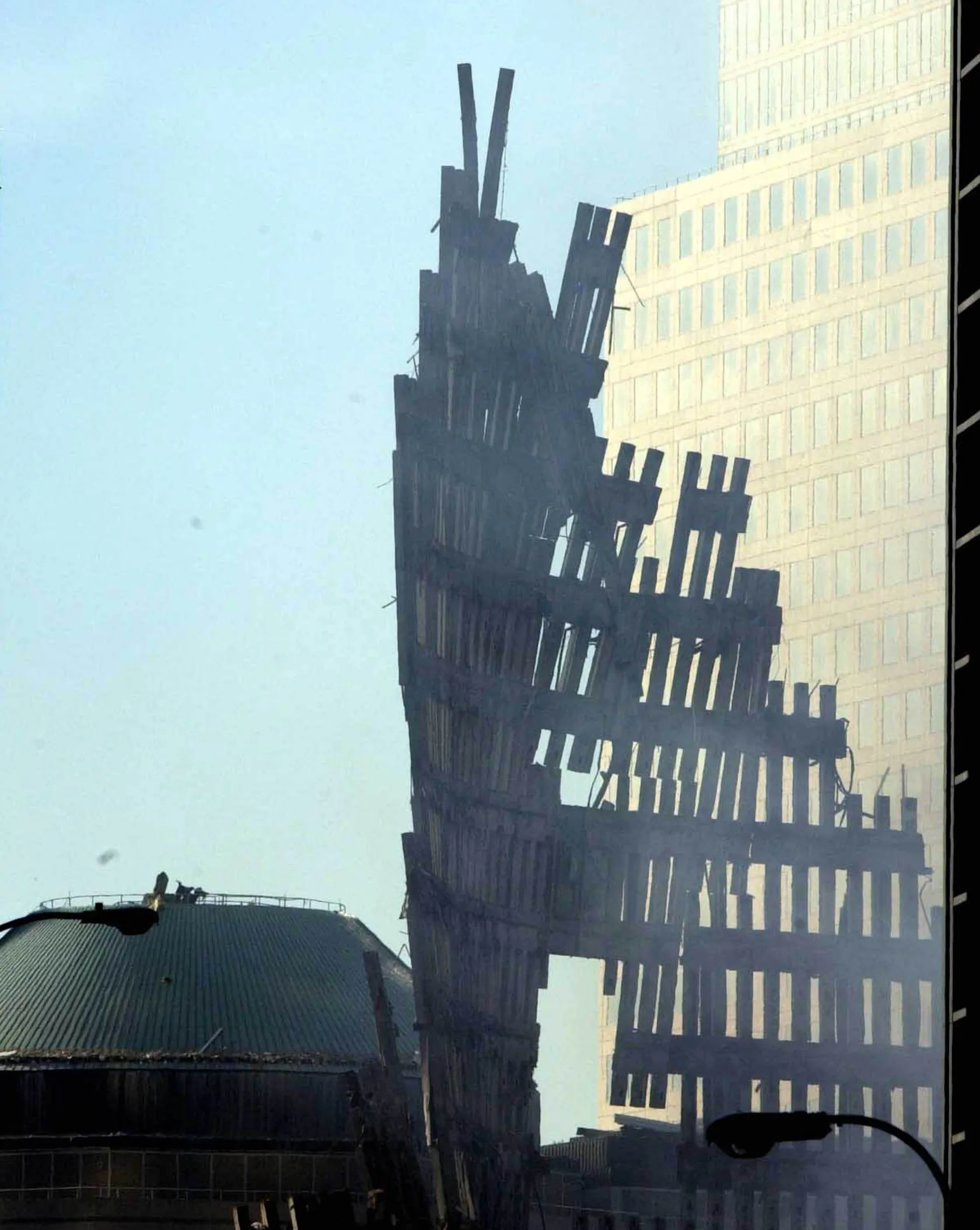
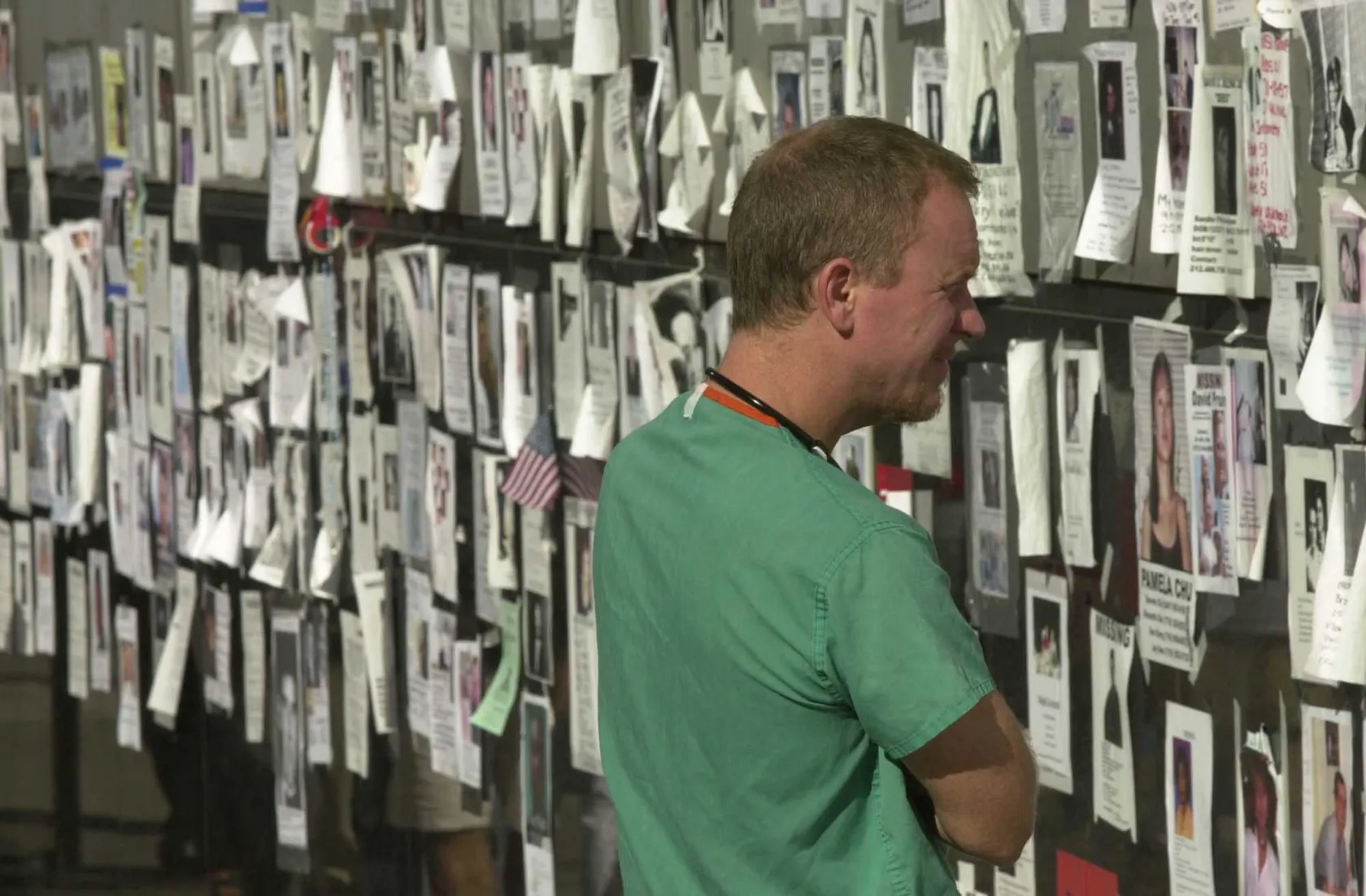
“We waited an hour in the hot September sun to clear security into the Ground Zero area,” remembered Smith. “Then we walked toward The Pile, still smoldering, wearing respirators, casting glances at the soldiers stationed on every street corner, every one of them wearing deadly serious scowls and clutching automatic rifles.”
Most stories were close to home, however. Sometimes very close. Being located in the center of the city could put the Sun-Times practically on the scene, such as when a northbound Lake-Dan Ryan trained plowed into an Evanston Express at the State-Lake station in 1977, practically within sight of the newspaper’s office.
To get a sense of how emotional covering such stories can be, a Sun-Times reporter arriving at the L accident found himself instead helping a victim whose mother had died before her eyes.
“‘What do I do?’ she asked me,” the reporter wrote. “‘My mother is dead. What do I do?’ I didn’t know what to tell her. ‘Why couldn’t it have been me?’ she asked. ‘Why not me?’”
The reporter left the scene to drive the woman to a North Side bakery where her friends were, and refused to put his byline on the next day’s story, credited only “By a Sun-Times Reporter” and starting with this note: “The reporter who wrote this story did not want his name used. He got involved — to help, not to get a byline.”
One of the hardest things to convey is the confusion of these chaotic situations. Roger Simon got to the heart of it at the L crash by just listening to rescue efforts.
“The sound Friday night was the worst thing,” he wrote. “After a few minutes, the screaming stopped. And from the cars themselves came only silence. Sobbing people, gasping in the cold air, were led away. The foghorn honks of the fire trucks trying to clear a path mixed with the continual barking of frustrated police who could not keep the curious away.
“There were the shrill whine of the power saws, growling when they bit into the metal cars, and the hiss of the acetylene torches as they reached where the saws could not.”
Paxton Hotel Fire
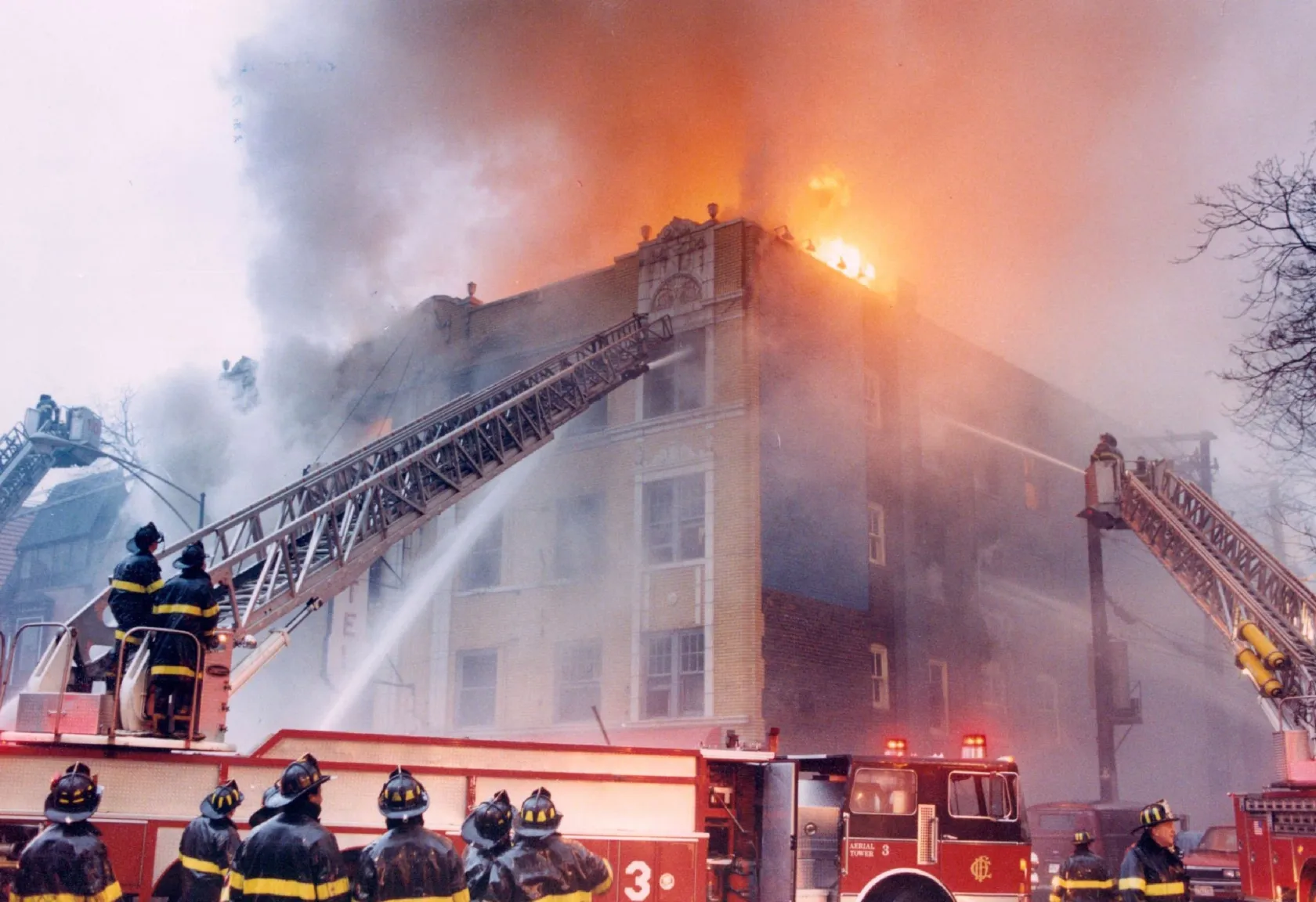
Most reporters who’ve spent any time at the Sun-Times had such experiences. I worked the night shift for seven years, and had my share of tragedies, particularly fires. Such as the the Paxton Hotel, a low-income residence that burned on March 16, 1993. I lived in East Lake View, and my phone rang at 4:35 a.m. that day. Ten minutes later I was running down the wet cobblestones of the alley to my car and could hear sirens in the distance. The smoke was so thick it set off smoke alarms at nearby buildings.
It was still dark, the scene lit by amber streetlights and fire department spots — thick beige smoke pumping out of the windows, flames shooting from the roof. Paramedics were working on victims in the middle of the street, pressing on their chests, doing CPR. The wind was strong, and would occasionally shift, the smoke suddenly so thick everything went stingingly black, and I clamped my eyes shut and reached out to a telephone pole, just to have something to hold onto, and waited.
An Updated List of Victims
Mid-morning, I went with two other reporters to file our stories at the newspaper, still at 401 N. Wabash. We got in an elevator, suddenly finding ourselves among bright, freshly scrubbed people with briefcases and neckties. Every head pivoted in our direction because we reeked of smoke. A moment that drove home the gap between being a reporter and being a reader.
Lynn Sweet was the paper’s political writer, not the job to typically cover fires. But the Paxton was near where she lived at the time, so she hurried over anyway, on her own initiative.
“It’s what reporters do. You go to the fire,” said Sweet. “I smell the smoke forever.”
Getting to the scene, gathering the news, however awful — 19 people died at the Paxton Hotel — and bringing it to Chicago and the world, is one of the important roles in civic life that the Sun-Times has played for 75 years. Its staff of reporters and photographers don’t set the fires and don’t put them out, only hurry to the scene, talk to those involved, look around, and share the story as best we can.
Development and design by Jesse Howe/Sun-Times


